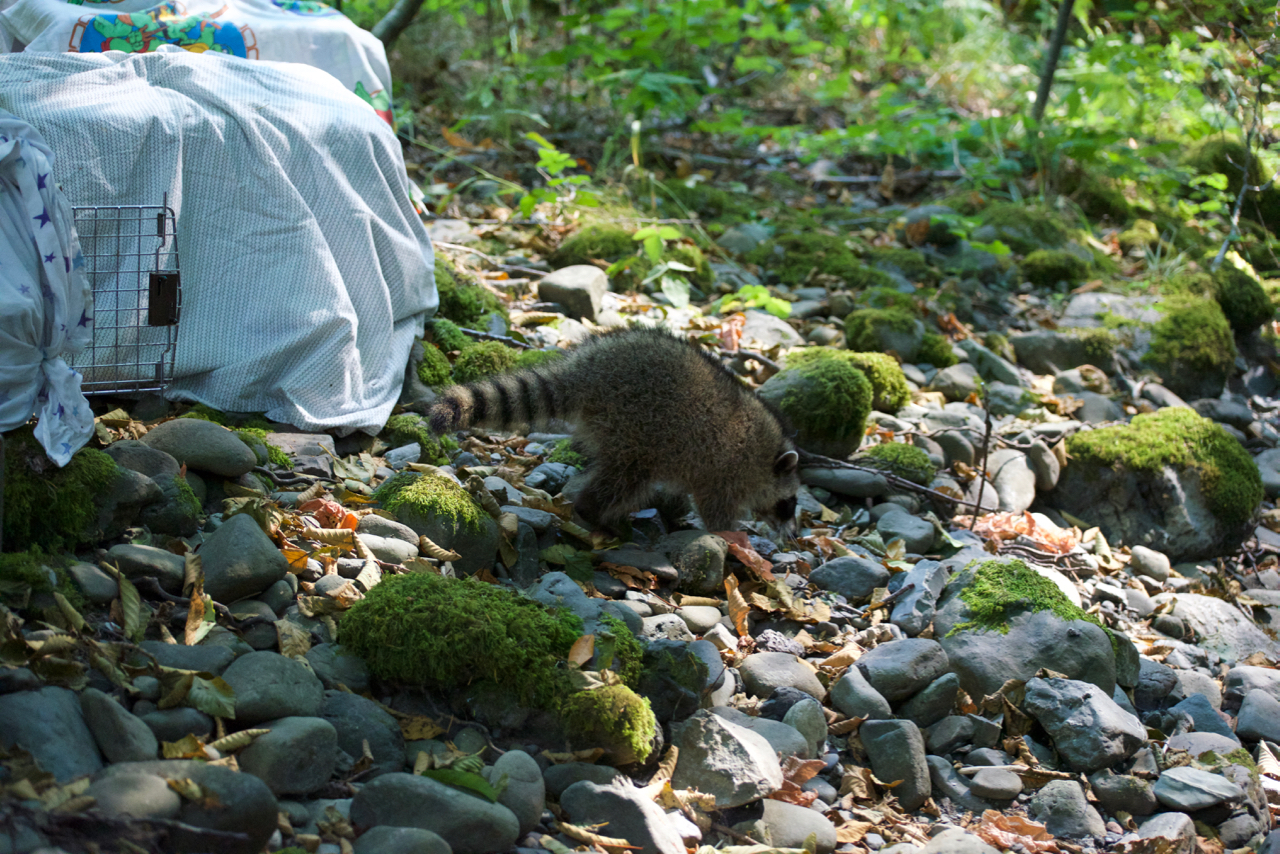
Even in a world in turmoil, some things remain constant. One of those things is the time needed for baby raccoons to reach an age where we feel their ready for independence. Our most typical orphaned raccoon patient is admitted at the time when they’ve started to become vocal (which is how they’re found) which is right before their eyes open, somewhere around 200 to 250 grams. By the time they’ve grown to 350-400 grams their eyes open. After 6 more weeks of milk and slowly introduced natural food items, as they are weaned from milk-replacer, the babies are fierce, active, alert, and extremely curious – like any bright toddler.
(check out other raccoon stories on our website! http://birdallyx.net/tag/northern-raccoon/ )
In order to reduce the potentially fatal stress of captivity (no one likes their freedom taken!) as well as ensure that each youngster maintains her wild spirit, at this point, we handle them very infrequently. This also ensures that all keep a healthy fear of humans, who, let’s face it, have a poor track record with all things wild and free.
Raccoon orphans typically start coming in to Humboldt Wildlife Care Center/bax in early May… and 16 weeks later, in early September, those who were first admitted are ready for release.
 Weight checks on raccoons who are nearing release can be challenging! Here HWCC rehabilitator Lucinda Adamson holds a young raccoon gently but firmly while intern Tabytha Sheeley (facing away) assists with identification.
Weight checks on raccoons who are nearing release can be challenging! Here HWCC rehabilitator Lucinda Adamson holds a young raccoon gently but firmly while intern Tabytha Sheeley (facing away) assists with identification.
 Once weaned, all of our orphaned raccoons are moved to a 14 day weight check. The reduction in handling does them a world of good!
Once weaned, all of our orphaned raccoons are moved to a 14 day weight check. The reduction in handling does them a world of good!
 Raccoons who are ready to go wait for their ride to the release site.
Raccoons who are ready to go wait for their ride to the release site.
 At the release site: tentative faces peer out. Caution in the face of novelty is the hallmark of being wild!
At the release site: tentative faces peer out. Caution in the face of novelty is the hallmark of being wild!
 And curiosity eventually overpowers! There’s a whole wide world to explore and raccoons, intelligent, investigative and irrepressible, soon leave the familiar crates for the limitless cosmos.
And curiosity eventually overpowers! There’s a whole wide world to explore and raccoons, intelligent, investigative and irrepressible, soon leave the familiar crates for the limitless cosmos.
 One by one, the five raccoons emerge from their transport carriers, the last box that will ever contain them!
One by one, the five raccoons emerge from their transport carriers, the last box that will ever contain them!
 Some elements of the natural world – rock, river, insect, leaf – are familiar to the youngsters. Our raccoon housing is built to introduce wild orphans to many of the the resources they’ll use once they’re independent and free.
Some elements of the natural world – rock, river, insect, leaf – are familiar to the youngsters. Our raccoon housing is built to introduce wild orphans to many of the the resources they’ll use once they’re independent and free.


 In this group of raccoons, two are siblings, but all five have been housed together since they were first weaned. Raccoons form bonds – bonds of family, bonds of friendship – just like many of us.
In this group of raccoons, two are siblings, but all five have been housed together since they were first weaned. Raccoons form bonds – bonds of family, bonds of friendship – just like many of us.


 Soon, they all start to look across the river to the ever widening world.
Soon, they all start to look across the river to the ever widening world.

 They cross the river together.
They cross the river together.



 HWCC/bax volunteer Skylr Lopez (right) and intern Tabytha Sheeley watch the young raccoons move farther and farther away. Like sending our kids off to college, releasing our patients after four months of providing their care is a joy that is tinged with sadness.
HWCC/bax volunteer Skylr Lopez (right) and intern Tabytha Sheeley watch the young raccoons move farther and farther away. Like sending our kids off to college, releasing our patients after four months of providing their care is a joy that is tinged with sadness.
 Five raccoons facing their future, not looking back.
Five raccoons facing their future, not looking back.

We often say that we raise wild orphans – but we don’t really. We provide milk-replacer at the appointed hour for those who would still be nursing – we feed insects on a tight schedule to baby birds who cannot feed themselves. We keep their housing clean. We keep them physically healthy. But teaching them to be adults of their kind is something each orphan patient must do for herself. Each baby is given housing in which he can learn safely. We don’t teach them anything. We provide the setting for them to make discoveries. In fact it is the orphan wild animals in our care who do the teaching. Everything that we know about their needs, we learned from them.
Their teaching and your support are what make successful raccoons like these five possible. So far in 2018 we’ve treated over 900 wild animals – our busiest year in HWCC history! Your support is needed now more than ever! Thank you!
all photos (Laura Corsiglia/Bird Ally X)


